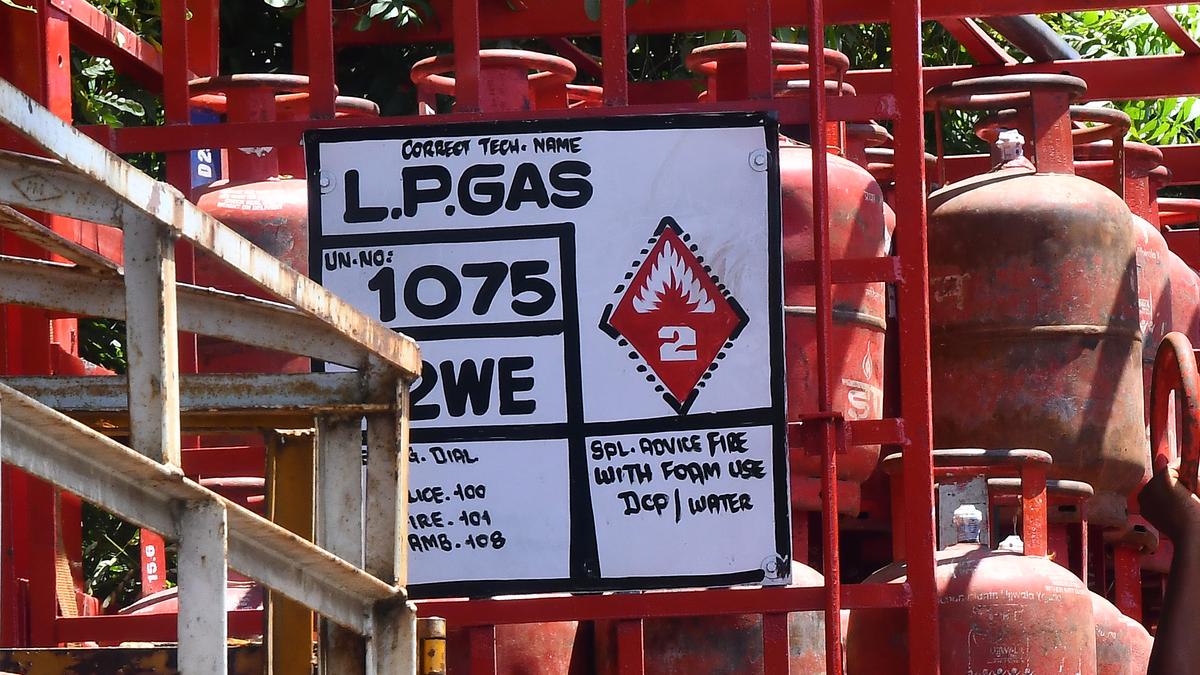In the rural areas of J&K, 85.07% of the households have official LPG connections. Nearly 68% of these were procured under the PMUY. File
| Photo Credit: The Hindu
The International Energy Agency says about 681 million people in India rely on solid fuels for cooking. This poses series health and environmental concerns. The Pradhan Mantri Ujjwala Yojana (PMUY) aims to promote the adoption of clean fuel by providing subsidised LPG connections to poor households. So far, the government has provided 10.3 crore LPG connections under this scheme. We studied the impact of the scheme in Jammu and Kashmir.
The study utilises primary survey data from 820 households across 48 villages in the districts of Kulgam and Rajouri, which are relatively disadvantaged. A systematic random sampling method was employed, with 24 villages selected from each district, ensuring coverage of all the tehsils within the districts. The number of villages chosen from each tehsil was proportional to its population size. The survey design ensures representation from different economic categories, including Above Poverty Line (APL), Below Poverty Line (BPL), and Antyodaya Anna Yojana (AAY) households. Comprehensive questionnaires were administered to female household members who were responsible for cooking.
LPG connection adoption
We found that in the rural areas of J&K, 85.07% of the households have official LPG connections. Nearly 68% of these were procured under the PMUY. Only 4.41% of households in rural areas, particularly in hilly regions such as Rajouri (in Jammu), do not have access to LPG, while 10.53% rely on unofficial connections.
However, despite this substantial increase in LPG availability, traditional cooking methods remain pervasive. About 92% of the households still maintain traditional chulhas, and 85% of the households engage in fuel stacking, using both solid fuels and LPG. This pattern is reflective of cultural attachment to traditional cooking methods, as well as the problem of affordability, which limits exclusive reliance on LPG.
The average number of LPG cylinders consumed per household in the last six months is 3.56, which indicates moderate usage. In Kulgam, the PMUY beneficiary households reported a higher adoption rate (3.54 cylinders) than eligible non-PMUY consumer households (3.21). In Rajouri, the adoption rate among PMUY beneficiary households is lower than general consumer households. The reliance on solid fuels such as firewood, with an average consumption of 226 kilogrammes per household in six months, reflects the dual-use cooking system.
One of the primary objectives of PMUY is to alleviate the health burden on women by reducing their exposure to indoor smoke from traditional cooking fuels. The survey revealed significant health benefits for women in households that adopted LPG under the PMUY, in Kulgam. Among BPL households, the incidence of respiratory problems, such as coughing, chest infections, and headaches, showed a marked reduction. Non-PMUY beneficiary BPL households reported a 24% incidence of coughing during the one-month period immediately preceding the data collection, while PMUY beneficiaries saw a drop to 21%. The reduction is even more significant in AAY households, where non-beneficiaries reported a 13% incidence of coughing, but beneficiaries saw it drop to 10%. Similar trends were observed for headaches and chest infections.
Households with additional appliances such as rice cookers, and educated members, also experienced better health outcomes. For instance, PMUY beneficiaries with rice cookers reported a reduced incidence of coughing (20%) compared to non-beneficiaries. Households where the main cook had secondary or above education saw the incidence of chest infections drop to 4% among BPL households.
Barriers to exclusive LPG usage
However, certain barriers continue to hinder exclusive reliance on clean cooking fuel. The first is the lack of awareness about the health benefits of LPG. In the survey, 47% of the households were unaware of the health risks associated with solid fuel use. This is compounded by the fact that 64% of the households do not own a TV, and 33% of households reported that the female members responsible for cooking do not possess a mobile phone. These gaps in communication highlight the need for targeted awareness campaigns.
The second barrier is financial. The cost of refilling LPG cylinders remains a burden for many households. This often leads to fuel stacking, where households resort to cheaper but more harmful solid fuels. Fuel stacking remains prevalent in 85% of the households, underscoring the need for more comprehensive financial support to make LPG refills more affordable.
The study highlights the importance of awareness and access to modern appliances in promoting clean fuels. Households with greater awareness of health benefits of LPG reported higher LPG consumption (3.73 cylinders on average) and lower firewood consumption (216 kg) compared to those without such awareness. Also, households that did not perceive a taste difference between food cooked on LPG and traditional fuels were more likely to rely solely on LPG, with an average consumption of 4.27 cylinders. The availability of rice cookers correlates with a higher LPG usage (3.59 cylinders) as compared to households without these appliances.
Expanding the network of LPG distribution points in rural areas and extending financial support for refills could further increase clean fuel adoption.
Irfan Ahmad Sofi, Assistant Professor of Economics in IUST, Kashmir; Santosh Mehrotra, Taught economics at JNU, and is an independent economist
Published – November 14, 2024 12:57 am IST
